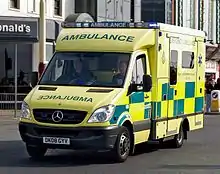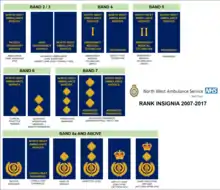North West Ambulance Service
The North West Ambulance Service NHS Trust (NWAS) is the ambulance service for North West England. It is one of 10 Ambulance Trusts providing England with Emergency medical services, and is part of the National Health Service, receiving direct government funding for its role.
| North West Ambulance Service NHS Trust | |
|---|---|
| NWAS | |
 The NHS corporate identity logo of North West Ambulance Service Trust | |
 Map of North West Ambulance Service's coverage | |
| Type | NHS trust |
| Established | 1 July 2006 |
| Headquarters | 399 Chorley New Road Bolton BL1 5DD[1] |
| Region served | Greater Manchester, Cheshire Merseyside, Cumbria, Lancashire and part of the High Peak district of Derbyshire |
| Area size | 5,400 sq. miles |
| Population | 7.5 million |
| Budget | £310 million (Approx) |
| Chair | Peter White |
| Chief executive | Daren Mochrie |
| Staff | 5,912 (2018/19)[2] |
| Website | www |
NWAS was formed on 1 July 2006 following the merger of four previous services (Cumbria Ambulance Service; Lancashire Ambulance Service; Cheshire and Mersey Ambulance Service; and Greater Manchester Ambulance Service) as part of Health Minister Lord Warner's plans to combine ambulance services.[3]
Based in Bolton, the new trust provides services to almost 7 million people in Greater Manchester, Cheshire, Merseyside, Lancashire, Cumbria, and the North Western fringes of the High Peak district of Derbyshire (covering the towns of Glossop and Hadfield) in an area of some 5,500 square miles (14,000 km2). NWAS provides emergency ambulance response via the 999 system, as well as operating the NHS 111 advice service for North West England.
They also operate non-emergency patient transport services (PTS), and in 2013/2014 carried out 1.2 million such journeys. Since 2016, the PTS in Cheshire, Warrington and Wirral has instead been carried out by West Midlands Ambulance Service.[4]
Fleet


NWAS utilise a mixed fleet of emergency ambulances, mainly based on the Mercedes-Benz Sprinter or Fiat Ducato, the former consisting of a demountable box body on a chassis, and the latter a van conversion. The Trust uses Skoda Octavia estates as the main Rapid response car although since 2017 begun using BMW i3 electric cars[5] and use Renault Masters for Intermediate, Urgent care and Patient Transport vehicles. In Central Manchester, some paramedics respond on specially converted bicycles.
Locations and structure
The trust currently operates from 104 ambulance stations across the North West.[6] The most northerly station is at Carlisle, and the furthest south is at Crewe. It also maintains three Emergency Operations Centres (EOCs) for the handling of 999 calls and dispatch of emergency ambulances.
- Parkway (Manchester Area)
- Estuary Point (Cheshire and Mersey Area) – formerly Elm House
- Broughton (Cumbria and Lancashire Area)
In 2017, NWAS signed an agreement to purchase a new EOC and area office for £2.9 million at Liverpool International Business Park next to Liverpool John Lennon Airport[7] As of 2019, this building has been converted and services have now migrated from the Anfield site.
Over recent years, the trust has combined many of their older ambulance stations into purpose-built facilities shared with other emergency services, including Greater Manchester Fire and Rescue, Lancashire Fire and Rescue and Greater Manchester Police.[8][9]
Structure


Since NWAS was formed in 2006, the trust adopted blue epaulettes to by worn by its staff to denote their clinical grade and rank (examples of these are found in Image 1). Prior to this, Greater Manchester Ambulance Service (GMAS) staff wore bottle-green epaulettes matching the colour of their uniform.
Following the creation of a National NHS Ambulance Service Uniform in 2015/2016, NWAS like many other trusts changed their epaulettes to dark green in order to match the colour of the new uniform (see image 2) which it gradually integrated alongside a structure change. In 2018, following a recommendation from the Kerslake Report into the Manchester Area Bombing, Red epaulettes were introduced for senior clinicians to make them easy to identify at larger incidents. Typically, NWAS uses the following Organisational Structure:
| Role | Service | Notes |
|---|---|---|
| Ambulance Care Assistant (ACA) | Patient Transport Service | Band 2 or 3 |
| Advanced Ambulance Care Assistant (AACA) | Urgent Care Service | Band 3 |
| Emergency Medical Technician 1 (EMT1) | Paramedic Emergency Service | Band 4 (Apprentice for first 12 Months) |
| Emergency Medical Technician 2 (EMT2) | Paramedic Emergency Service | Band 5 (formerly IHCD Technician, phased out since 2010) |
| Newly Qualified Paramedic (NQP1 / NQP 2) | Paramedic Emergency Service | Band 5 (NQP1 = First year, NQP 2 = Second Year) |
| Paramedic | Paramedic Emergency Service | Band 6 |
| Senior Paramedic Team Leader (SPTL) | Paramedic Emergency Service | Band 7 (Since 2019) |
| Operations Manager (OM) | Paramedic Emergency Service | Band 7, operationally responsible for a large ambulance station |
| Advanced Paramedic | Paramedic Emergency Service | Band 7, clinically responsible for a large ambulance station, works alongside an OM. |
| Sector Manager | Paramedic Emergency Service | Band 8b, operationally responsible for a geographic sector |
| Consultant Paramedic (CP) | Medical Directorate | Band 8b, clinically responsible for a geographic area (including its APs) and works alongside HoS |
| Head of Service (HoS) | Service Delivery | Director responsible for a geographic or service area |
| Chief Consultant Paramedic | Medical Directorate | Works alongside AMD & MD's as senior paramedic lead. Clinically responsible for all CP's |
| Deputy Director & Directors of Service | E.g. Deputy Director of Operations, Assistant Medical Directors | |
| Executive Directors | E.g. Executive Director of Operations, Executive Medical Director | |
| Deputy Chief Executive Officer | ||
| Chief Executive Officer (CEO) |
Performance
NWAS was the first ambulance trust to be inspected by the Care Quality Commission (CQC), in August 2014. The CQC found the trust provided safe and effective services which were well-led and with a clear focus on quality but it was criticised for taking too many callers to hospital and for sending ambulances when other responses would have been more appropriate.[10] The Trust was subsequently inspected in 2018 and was found to have improved with a rating of "Good"[11]
See also
References[12]
- "Contact details - North West Ambulance Service NHS Trust". Care Quality Commission. Retrieved 28 December 2019.
- "Annual Report 2018/19" (PDF). North West Ambulance Service NHS Trust. Retrieved 28 December 2019.
- "Where we are". nwas.nhs.uk. North West Ambulance Services. Retrieved 3 April 2014.
- "North West Ambulance Service loses contract to cover Cheshire". Chester Chronicle. 1 January 2016. Retrieved 2 January 2016.
- "Ambulance service looks to save millions by leasing BMW i3 electric vehicles". Contract hire and leasing. 27 Feb 2017. Retrieved 14 November 2017.
- "North West Ambulance Service NHS Trust - Where we are". www.nwas.nhs.uk. Retrieved 2019-04-13.
- Contributor, Community (2017-07-31). "New home for Merseyside Ambulance staff". liverpoolecho. Retrieved 2019-04-13.
- "VIDEO: Take a look inside Lancaster's new community fire and ambulance station". www.lancasterguardian.co.uk. Retrieved 2019-04-13.
- "Fire and ambulance services teaming up in new station". www.wigantoday.net. Retrieved 2019-04-13.
- "North West Ambulance Service gets mixed Care Quality Commission report". BBC News. 10 December 2014. Retrieved 12 January 2015.
- "North West Ambulance Service NHS Trust". www.cqc.org.uk. Retrieved 2019-04-13.
- "North West Ambulance Service Website". North West Ambulance Service Website. NWAS. 2014-07-15.
External links
| Wikimedia Commons has media related to North West Ambulance Service. |